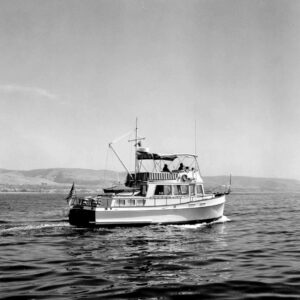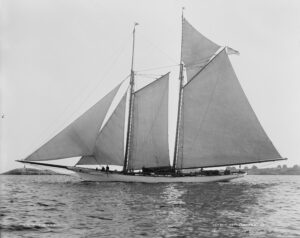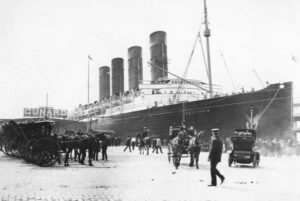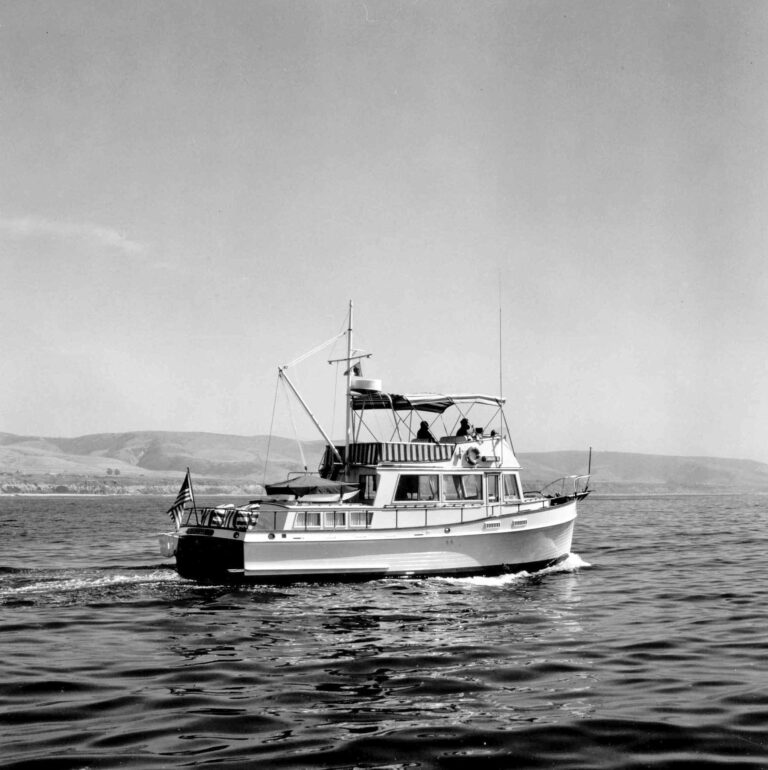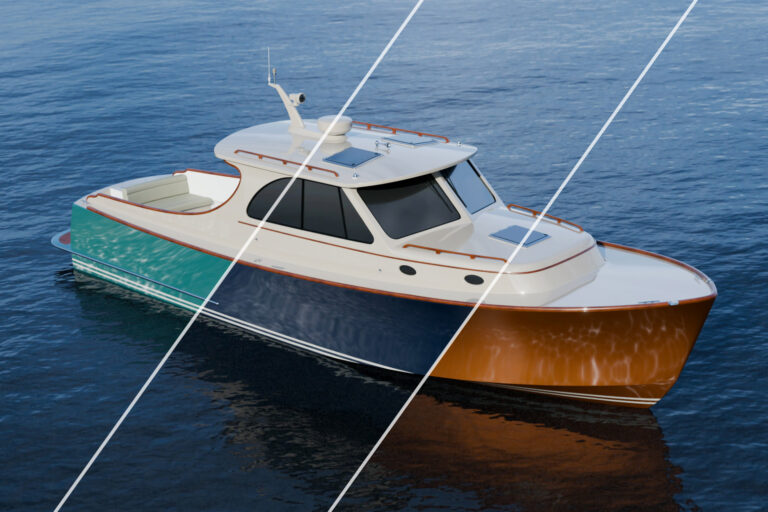The Ocean Classroom Foundation, a nonprofit sail-training organization that closed its doors at summer’s end after 20 years of educating students at sea, has sold its tall ships — Harvey Gamage, Spirit of Massachusetts and Westward — to operators who plan to put one, maybe two, of the schooners back on the water in semester-at-sea programs and the third into service as a dockside attraction in southern Maine.

Meanwhile, Connecticut’s attorney general has placed Amistad, Connecticut’s tall ship, which Ocean Classroom managed for 20 months, under a private receiver who is tasked with helping the ailing nonprofit untangle its finances. The 129-foot (LOA) topsail schooner will continue to operate while under the receivership of New Haven, Connecticut, lawyer Katharine B. Sacks, who is now the chief executive of Amistad America, the New Haven-based nonprofit that operates the replica slave ship.
“Continuity of operations is essential, and we do not expect the receivership to interfere in any way with the Amistad’s currently planned schedule of activities,” says Connecticut Attorney General George Jepsen.
Likewise, the Ocean Classroom vessels’ educational mission — to teach young people through hands-on study and help them in their personal growth through the traditions, values and adventure of the seafaring life — remains intact, says Peter Neill, board chairman of the Portland and Camden, Maine-based Ocean Classroom.
Phineas Sprague Jr., owner of Portland Yacht Services in Portland, Maine, has bought Harvey Gamage, a 131-foot (LOA) wooden coasting schooner built in 1973, and Westward, a 125-foot (LOA) North Sea pilot schooner launched in 1961. “When Ocean Classroom got into trouble, I put an umbrella over its head [and helped the organization financially],” Sprague says. “When the bank pulled the plug on them, I ended up with the boats.” That’s not what he planned, but Sprague — who did a five-year circumnavigation with his wife, Joanna, on an 81-foot Alden schooner in the early 1970s — is giving Ocean Classroom the chance to keep running sea education programs under all-new leadership and a new board of directors.
“Sailing has been a huge part of my life,” he says. “I have some nieces who went through the Ocean Classroom program. I know how much Ocean Classroom has done for so many people. … I don’t think there’s anything better for children than for them to experience the water and hold the tiller and pull on the shrouds.”
Harvey Gamage is in Sprague’s yard for a refit and upgrade that before Ocean Classroom’s demise was estimated to be a $150,000 job. She is expected to be back on the water doing one- or two-week educational cruises by next June and should be doing semesters at sea again by the spring of 2016, says Margo Millar, Ocean Classroom’s new executive director. “We’ve got a new board, kick-starter funds to get us through the next couple of phases,” and she’s working on fund-raising, curriculum and accreditation.
Westward’s future remains clouded. At last inspection, the steel-hulled vessel needed about $1 million of work on her bottom and bulkheads. “That’s a different kettle of fish,” Sprague says. Built in Germany at the Abeking & Rasmussen shipyard, Westward started as a research vessel. Sprague says he’ll have to haul her and assess her condition. “We’ll sit down and think about that boat,” he says. “It’s hard to figure out how to save it.”
Spirit of Massachusetts, a 1984 125-foot (LOA) fishing schooner, has been purchased by Dwight Raymond, owner of the Pilot House Restaurant and Performance Marine in Kennebunk, Maine, Sprague says. Spirit also was at Sprague’s yard, for work on her deck and bright-work. She likely will become a dockside attraction, part of a harborfront restaurant complex, says Greg Belanger, Ocean Classroom’s former executive director.

All three vessels were purchased debt-free, their undisclosed sales prices going directly to Camden National Bank, which held Ocean Classroom’s $2 million mortgage, Belanger says. There was no bank foreclosure or bankruptcy filing, he says. Torpedoed by hard economic times, the ships will have the chance to work again.
Meanwhile, Ocean Classroom’s fall semester-at-sea students are sailing and studying in the Caribbean, as scheduled, as transfers to the World Ocean School’s Schooner Roseway, a 137-foot (LOA) 1925 gaff-rigged schooner based out of Boston.
Financial fallout
Ocean Classroom, like other sail-training organizations, had not recovered from the Great Recession when charitable donations — a critical part of tall-ship budgets — and student enrollments dried up while bank debt and maintenance bills mounted, Belanger says. Ocean Classroom is one of several tall-ship organizations that have foundered. In June, the defunct South Carolina Maritime Heritage Foundation — saddled with a $2 million debt — sold its 90-foot pilot schooner Spirit of South Carolina to two Charleston businessmen who paid $440,000 for the $4 million vessel. As the state’s tall ship, it will stay in Charleston, but the new owners haven’t divulged their plans for it.
The Virginia Maritime Heritage Foundation’s schooner Virginia, a 126-foot pilot schooner and Virginia’s tall ship, curtailed its sailing programs in August and is for sale now to pay off the foundation’s $1 million debt. Virginia, launched in 2004, sailed out of Norfolk. And in the Maine windjammer fleet, U.S. marshals seized the 82-foot Nathaniel Bowditch in December 2013 for failure to meet its loan payments. When no bidders turned out for its auction, mortgage-holder Thomas Federle submitted a bid of $250,000 and bought her. Marshals also seized the 96-foot Maine pilot schooner Timberwind in May for default on a $325,000 loan; the vessel is for sale for $421,000.
The financial troubles are “symptomatic of the challenges that this industry faces,” says Neill, a past director of maritime preservation for the National Trust for Historic Preservation and president of the South Street Seaport Museum. Tall-ship operations have run into some stiff head winds. Discretionary income and philanthropy collapsed after 2008, sharply pinching income at Ocean Classroom, Neill says. Student enrollment also declined, and although demand for semesters at sea picked up in 2009-10 despite the $20,000 tuition, cash flow, though keeping pace with operational costs and routine maintenance, couldn’t pay for capital improvements — the big repair projects. In the end, it was capital improvements it couldn’t afford to undertake that sank Ocean Classroom: $1 million for work on Westward’s bottom and a watertight bulkhead, $700,000 for a 10-year refit for Spirit of Massachusetts and $150,000 for yard work on Harvey Gamage. With no money for the work, Westward hadn’t sailed since 2011. Spirit of Massachusetts also had to be sidelined.
Only Gamage was in good enough shape to keep going. “This was the perfect storm,” Belanger says. “Declining contributions, declining tuition, two boats out of service.”
Neill says Ocean Classroom went to Camden National Bank and asked for a 3- to 5-year extension on its $2 million debt so it could pay for the work on the ships, but the bank declined to restructure the loan, despite the fact that it was not non-performing and Ocean Classroom had paid more than $350,000 in interest and retired $500,000 of its debt. “[The bank] had not been in this business before and didn’t understand how hard it is, how complex it is,” Neill says.
Operational income was sufficient to cover operations and routine maintenance. Charitable donations weren’t enough to cover capital expenses. “We failed to get the philanthropy,” Neill says. “That’s where we failed after 2008.”
Belanger identified other pitfalls. “You have to keep an eye on debt accumulating on the capital side,” he says, and avoid deferred maintenance leading to “huge capital needs.”
Neill says, too, that the October 2012 sinking of the Bounty, the 108-foot wooden square-rigger, off North Carolina in Hurricane Sandy “didn’t help.” A Coast Guard inquiry found that besides the skipper’s poor decision-making, wood rot, faulty pumps and a leaky hull contributed to the loss. The Coast Guard is “much more meticulous” now when it inspects tall ships, and this has driven up maintenance costs, Neill says.
Belanger says Ocean Classroom moved its marine operations from Boothbay to Portland and partnered with Portland Yacht Services to save money, chartered vessels, increased its number of semesters at sea and added a service program that took students to the Dominican Republic to work in an orphanage to make headway. It was not enough. Ocean Classroom needed a better business model for the times.
When the organization began managing Amistad in November 2012, it was part of an effort to partner with other nonprofits for mutual benefit. Amistad paid Ocean Classroom $5,000 a month, which paid for insurance, management services and an upgraded maintenance program, and the two nonprofits split the program revenue. Neill says Ocean Classroom took on Amistad to try to save it, Connecticut’s tall ship organization being in extremis financially, as well, Neill says. “It was a rescue mission that we thought we were obligated to do.”
Belanger, who had been executive director at Amistad before taking that post at Ocean Classroom, says that as it turned out, Connecticut’s tall ship was not suitable for sail training, but he secured a gig for her filming a TV miniseries on the pirate Blackbeard in Puerto Rico, which earned $250,000 for the two organizations. He also leased her for use in filming The Book of Negroes, which was shot in Nova Scotia. That was about African Americans who fought for the British in the Revolutionary War and the War of 1812 and migrated to Sierra Leone to found the village of Freetown. It raised $50,000 for the struggling nonprofits.
The New Haven-based Amistad also tours ports, telling the story and teaching the lessons of the 49 slaves who wrested control of the original ship from its captain in 1839 while sailing to a plantation in Cuba. They were subsequently captured and imprisoned in New Haven, where they won their freedom — and a return voyage to Africa — in a landmark case that went all the way to the U.S. Supreme Court.
Belanger’s involvement with Amistad and Ocean Classroom at a time when both were foundering has drawn a slew of criticism in Connecticut, chiefly from The Day newspaper, of New London, and state Rep. Diana Urban (D-Stonington), who called for the state to investigate whether Amistad America misappropriated $359,000 in annual grants. A state audit revealed that the organization’s finances from 2009 to 2012 began to deteriorate after federal grants of nearly $500,000 stopped in 2010 and that the organization began to lose hundreds of thousands of dollars each year thereafter. The audit found no money missing or misappropriated, but it did take Amistad America to task for poor internal financial controls and a failure to meet some state grant reporting requirements, a mistake that was attributed, at least in part, to the fact that Amistad couldn’t afford professional accounting help. Neill says a financial audit of Ocean Classroom concluded that it had spent the monthly management fees it received from Amistad as required in the contract. “We did exactly what we said we’d do,” he says. “We returned Amistad [this September] in far better shape than when we took on her management,” although she was still operating in the red. Amistad isn’t out of the woods yet. After the audits’ release in early August, Urban called for additional audits back to 2006 to look at financial troubles predating the recession.

Tall ship business models
Belanger, who is acting as a consultant in the breakup of Ocean Classroom, says Harvey Gamage will operate under a new and — he hopes — more successful business model. The tall-ships industry is facing a lot of challenges. “That doesn’t mean the industry can’t survive,” he says. “We must have a viable business model.”
Harvey Gamage is owned by Sprague, who will take care of its repair, scheduled maintenance, refits and capital improvements. He will charter the vessel as a bareboat to the nonprofit Ocean Classroom, which will develop its educational and sail-training programs, market it, recruit students, and staff and operate the boat. The charter fees Sprague receives will pay for Gamage’s upkeep.
Sprague says school ship managers typically focus on the students and the educational program, and forget to provide for the long-term care and maintenance of the vessel. “When it comes down to the end of five years and it’s time [to renew the vessel’s Coast Guard Certificate of Inspection], they don’t have the money to refit the boats because they didn’t set any aside. It’s really hard to go to your donors and ask for that money. … My thought was I’d own the boat and essentially lease it out as a bareboat charter at a fixed cost over five years. That way, you have enough money to do the refit.”
The semester-at-sea model — in which students sail the boat, learn to navigate and assume responsibility for daily maintenance and upkeep while taking accredited coursework keyed to the weather and ocean sciences and the culture, history, economics and geography of the places they visit — “is still a terrific model for educating, in particular, teenage high-school students,” Belanger says. “There’s still a demand for this kind of program. … Parents tell us that their kids return to them completely different. They know what to value in life. They bond in friendships that last a lifetime.”
Belanger says the new nonprofit will forge alliances with other nonprofits, such as Sail Maine, the Maine Island Group and the Landing School. Education programs will be tailored to the demands of today’s more competitive college admissions environment. Semester-at-sea programs must be pedagogically rigorous, he says. Executive director Millar says Ocean Classroom will establish a landside presence with maritime-related classes for students during their vacations, develop strong ties to the Portland community and reconnect with alumni, who number 500 to 600 semester-at-sea graduates and more than 15,000 other students.
Alix Thorne, who bought Harvey Gamage with her former husband in 1990 and co-founded Ocean Classroom Foundation eight years later with the Harvey Gamage and Spirit of Massachusetts, says that after some soul-searching she has identified factors she thinks contributed to Ocean Classroom’s demise: the closing of Long Island University’s Southampton College, which ended a long and successful semester-at-sea partnership; the inability to start similar programs from scratch at the University of Maine and University of Massachusetts Dartmouth (the nonprofit ran a semester-at-sea program to the end with Proctor Academy, a college preparatory school in Andover, New Hampshire); the rising costs of insurance, fuel and yard work; a slowness in expanding the board, which could have grown its network of philanthropic contacts (Thorne said she relied too much on her own contacts to raise money); the organization’s failure to develop a strong community support base when it moved from Newport, Rhode Island, to Camden; its laser-like focus on semesters-at-sea, which it could have augmented with shorter-duration cruises, day sails and dockside attraction work to bring in more income; restrictions on students using their federal financial aid for programs such as Ocean Classroom’s that are not technically university programs, although they are accredited by the university; a failure to mount successful capital campaigns for major ship repairs and upgrades (Ocean Classroom did well in raising scholarships for students, those campaigns often raising $100,000 to $120,000); and a failure to make good use of electronic and social media to stay connected with a support base.

“This has been my life for a long time,” she says. “I care a lot about the ships and the people who have worked on them. I feel terrible about what’s happened and hope the ships find new homes and keep going with the same mission we kept going with.”
Ships need capital
The wave of recent tall ship layups does not tell the whole story of the school ship industry today, says Bert Rogers, executive director of Newport-based Tall Ships America, which fosters education and character building on its 70 member vessels. Yes, everyone in the tall ships business took a hit from the recession, but some survived it and others didn’t, Rogers says. “Each organization has to sail on its own bottom. Each has different strengths and different vulnerabilities. Sometimes you get past the point of recovering. When that happens, it’s hard.”
Rogers, a co-founder of Ocean Classroom and its executive director from 1996-2007, agrees that the organization failed to develop a “broad base of philanthropic support” for the capital needs of an aging fleet of school ships. It moved its base from Newport to Camden to try to tap into a community of support there, then moved the vessels to Portland, Maine, but the support never materialized.
Rogers says other organizations have made a strong recovery, mainly through private capital infusions or government grants. In May, Pennsylvania allocated $4.8 million to refurbish and rebuild the 123-foot (LOA) brig Niagara. Launched in 1988 as Pennsylvania’s tall ship, Niagara is based in Erie and is a reproduction of U.S. Navy Commodore Oliver Hazard Perry’s relief flagship on the Great Lakes during the War of 1812.
In July, two philanthropists donated $2.8 million, which along with $2.5 million from Massachusetts and $1 million from the Schooner Ernestina-Morrissey Association, will fund the reconstruction of the historic Ernestina and enable the 112-foot (LOA) Gloucester fishing schooner, arctic explorer and packet ship to carry passengers again as Massachusetts’ tall ship. The 120-year-old vessel has not sailed since 2005.
Last year the Townsend, Washington-based 1913 gaff-rigged pilothouse schooner Adventuress finished a five-year, $1.2 million centennial restoration to keep the 101-foot (LOA) vessel sailing and teaching environmental conservation and historic preservation.
The Maritime Museum of San Diego is building a full-size reproduction of Spanish explorer Juan Rodriguez Cabrillo’s flagship galleon San Salvador and has raised $3.5 million of a total of $5 million to complete the project. In Sausalito, California, an organization called Educational Tall Ship is building a 130-foot square-rigger as a school ship, the Matthew Turner, and has raised $2.5 million of the $5 million needed to build it.
Rogers notes, too, that the federal government has restored funding for National Maritime Heritage grants, which were discontinued during the hard times, and will award $1.7 million a year for the next four years to worthy maritime projects.
He says a successful tall ship program must be managed well: Program managers must know their market, have the right vessel and innovative ideas for serving that market, and find and tap reliable revenue sources.
When the business climate turns nasty, “Those who have the determination and the strength to weather the storm come out the other side, and when the wind fairs up a bit they are able to get underway,” Rogers says. “But not everyone survives the storm.”
See related article:
– Learn, do, teach: sail training’s invaluable lessons
December 2014 issue


